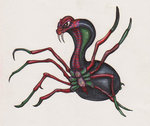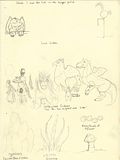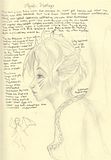The Pomo people participated in shamanism; one form this took was the Kuksu religion that was held by people in Central and Northern California. It included elaborate acting and dancing ceremonies in traditional costume, an annual mourning ceremony, puberty rites of passage, shamanic intervention with the spirit world, and an all-male society that met in subterranean dance rooms.[6][7] The Pomo believed in a supernatural being, the Kuksu or Guksu (depending on their dialect), who lived in the south and who came during ceremonies to heal their illnesses. Medicine men dressed up as Kuksu.
A later shamanistic movement was the "Messiah Cult", introduced by the Wintun people. It was practiced through 1900. This cult believed in prophets who had dreams, "waking visions" and revelations from "presiding spirits" and "virtually formed a priesthood." The prophets earned much respect and status among the people.
Culture
The people called Pomo were originally linked by location, language, and other elements of culture. They were not socially or politically linked as a large unified "tribe". Instead, they lived in small groups ("bands"), linked by geography, lineage and marriage. They relied upon fishing, hunting and gathering for their food.
Traditional narratives
Main article: Pomo traditional narratives
The record of Pomo myths, legends, tales, and histories is extensive. The body of narratives is classed within the Central California cultural pattern. Influences from the Northwest Coast and, more tenuously, from the Plateau region have also been noted.
Mythology
Main article: Pomo mythology
The Pomo had a strong mythology of creation and world order, that includes the personification of the Kuksu or Guksu healer spirit, spirits from six cardinal directions, and the Coyote as their ancestor and creator god.
Resources:
Most of the above from http://en.wikipedia.org/wiki/Pomo_people
Pomoan Language Map: http://linguistics.berkeley.edu/~survey/documents/maps/pomoan-languages-map.pdf
Native American unpublished language manuscripts: http://linguistics.berkeley.edu/~survey/resources/publications.php?publication=unpublished
http://en.wikipedia.org/wiki/Pomo_mythology
http://curtis.library.northwestern.edu/curtis/viewPage.cgi?volume=14&page=170
One of the most conspicuous features of the religion of the Pomo, who are south of the Yuki, is their shamanistic fetishes. The medicine-man possesses a number of objects, stones, parts of animals, and other articles, which he treasures and with which his power is largely bound up. Pomo mythology is characterized by the importance of Coyote, who comes nearer than any other personage to playing the part of creator. In certain ceremonies there are exhibitions of fire-eating and the clown occurs.
http://en.wikipedia.org/wiki/Charmstone
A charmstone is a mineral specimen believed by adherents of certain cultural or religious traditions to have healing, mystical or paranormal powers or energy.
The mineral specimen can be either natural and complete or cleaved from a natural stone; in some cases, the article may be entirely manufactured as in the case of certain Mayan pottery finds. For example, the Miwok and Pomo tribes of Northern California have left thousands of charmstones in the bed of Tolay Lake in Sonoma County. Tolay Lake is a public park: http://www.sonoma-county.org/parks/pk_tolay.htm
-----------------------------------------------------------------------------------------------------
Dieties and Sprits of Note
Kuksu among the Pomo and Maidu.
Monster of Blue Lakes
-----------------------------------------------------------------------------------------------------
Public Ceremonies
The following exerpts are from PUBLIC CEREMONIES. http://www.sacred-texts.com/nam/ca/ric/ric04.htm
"After the exclusion of such public observances as the shaman initiation, menstrual dance, and victory celebration, which, while generally participated in, are performed primarily for the benefit of individuals, the ceremonies of the California Indians which are of a really public or communal purpose and character fall into three classes: (1) mourning ceremonies; (2) initiation ceremonies connected with a secret society; and (3) a more varied group of dances and other observances which all, however, have in common the benefit either of the community or of the world at large, in that they cause a good crop of acorns and natural products, make the avoidance of rattlesnake bites possible, or prevent the occurrence of disease, earthquake, flood, and other calamities."
"Of these three classes of ceremonies the mourning ceremonies the mourning ceremonies further do not occur among the Athabascan, Yuki, and Pomo tribes to the south of the Northwestern tribes as far as the bay of San Francisco; but outside of this strip in the northern coast region they are universal in the state."
"Initiation ceremonies which result in something analogous to a secret society are found in the whole state except in the Northwestern region and among the agricultural tribes at the extreme southeast in the Colorado valley. They are apparently as well developed among the Yuki and Pomo, who practice tribal mourning ceremonies, as among their neighbors who do."
Bear shamans are much feared. All the Yuki possess a sacred society initiation ceremony, in which performances of magic are prominent. Among the northern Yuki and neighboring Wailaki this is called Flint ceremony, and the initiates display magic powers in handling and swallowing flint points. Among the southern Yuki, as among the neighboring Pomo and Athabascan Kato, the ceremony relates to ghosts and is popularly known as Devil dance. The members possess power of causing sickness and contend against each other much like the shamans of the Maidu and Yokuts.
-----------------------------------------------------------------------------------------------------
Eclipses
http://starryskies.com/The_sky/events/lunar-2003/eclipse7.html
The Pomo tribe of Native Americans are from the northwestern US. The Pomo name for a solar eclipse was "sun got bit bear." They tell a story about a bear who goes out for a stroll along the Milky Way. Soon Bear met up with the Sun and the two began to argue about who would move out of the other's path. The argument turned into a fight, which was represented by an eclipse of the Sun. Eventually the Bear continued along his way, but soon met up with the Moon, the Sun's sister. Again, an argument ensue about who would move over and again the argument turned into a fight. Now there was an eclipse of the Moon. After the eclipse Bear continued on his way along the Milky Way and the cycle repeated.
-----------------------------------------------------------------------------------------------------
Sources for Pomo Narratives
http://quod.lib.umich.edu/cgi/t/text/pageviewer-idx?c=moajrnl%3Bcc%3Dmoajrnl%3Brgn%3Dfull+text%3Bidno%3Da
http://curtis.library.northwestern.edu/curtis/viewPage.cgi?volume=14&page=170
- Angulo, Jaime de. 1935. "Pomo Creation Myth". Journal of American Folklore 48:203-262. (Eastern Pomo myth collected from W. Galganal Benson.)
- Angulo, Jaime de, and Lucy S. Freeland. 1928. "Miwok and Pomo Myths". Journal of American Folklore 41:232-253. (Myth versions from two Lake Miwok, one Eastern Pomo, and one Southeastern Pomo; Miwok and Pomo versions were reportedly almost identical.)
- Barrett, Samuel A. 1906. "A Composite Myth of the Pomo Indians". Journal of American Folklore 19:37-51. (Theft of Fire myth obtained in 1904, with commentary.)
- Barrett, Samuel A. 1917. "Pomo Bear Doctors". University of California Publications in American Archaeology and Ethnology 12:443-465. Berkeley. (Eastern Pomo myth about the origin of bear shamans, pp. 445-451.)
- Barrett, Samuel A. 1933. Pomo Myths. Public Museum of the City of Milwaukee Bulletin No. 15. Mikwaukee, Wisconsin. (Numerous myths, including Earth Diver, Theft of Fire, Orpheus, and Bear and Fawns, along with a detailed framework for comparisons.)
- Curtis, Edward S. 1907-1930. The North American Indian. 20 vols. Plimpton Press, Norwood, Massachusetts. (Four myths collected from San Diego (eastern Pomo), Sam Cowan (southern), Jim Ford (northern), and Tom Connor (central), vol. 14, pp. 170-173.)
- Erdoes, Richard, and Alfonso Ortiz. 1984. American Indian Myths and Legends. Pantheon Books, New York. (Retelling of a narrative from Barrett 1933, pp. 397-398.)
- Gifford, Edward Winslow, and Gwendoline Harris Block. 1930. California Indian Nights. Arthur H. Clark, Glendale, California. (One previously published narrative, pp. 287-296.)
- Judson, Katharine Berry. 1912. Myths and Legends of California and the Old Southwest. A. C. McClurg, Chicago. (Three myths, pp. 47, 63, 192.)
- Kroeber, A. L. 1911. "The Languages of the Coast of California North of San Francisco". University of California Publications in American Archaeology and Ethnology 9:273-435. Berkeley. (Includes a Pomo myth, pp. 343-346.)
- Kroeber, A. L. 1925. Handbook of the Indians of California. Bureau of American Ethnology Bulletin No. 78. Washington, D.C. (A brief note on mythology, pp. 270-271.)
- Loeb, Edwin M. 1926. "The Creator Concept among the Indians of North Central California". American Anthropologist 28:467-493. (Pomo creation myths, including Orpheus.)
- Loeb, Edwin M. 1932. "The Western Kuksu Cult". University of California Publications in American Archaeology and Ethnology 33:1-137. Berkeley. (Note on Northern Pomo mythology, pp. 3-4.)
- Luthin, Herbert W. 2002. Surviving through the Days: A California Indian Reader. University of California Press, Berkeley. (Three Eastern, Southern, and Cache Creek Pomo narratives collected in 1930, 1940, and 1988, pp. 260-333.)
- Margolin, Malcolm. 1993. The Way We Lived: California Indian Stories, Songs, and Reminiscences. First edition 1981. Heyday Books, Berkeley, California. (Three myths, pp. 69-71, 93-94, 126-129, from Angulo and Benson 1932, Barrett 1933, and Oswalt 1964.)
- McLendon, Sally. 1978. "Coyote and the Ground Squirrels (Eastern Pomo)". In Coyote Stories, edited by William Bright, pp. 87-111. International Journal of American Linguistics Native American Texts Series No. 1. University of Chicago Press. (Narrated by Ralph Holder in 1975.)
- Oswalt, Robert L. 1957. Kashaya Texts. University of California Publications in Linguistics No. 36. Berkeley. (Narratives, including Bear and Fawns, collected in 1957-1961.)
- Powers, Stephen. 1877. Tribes of California. Contributions to North American Ethnology, vol. 3. Government Printing Office, Washington, D.C. Reprinted with an introduction by Robert F. Heizer in 1976, University of California Press, Berkeley. (Three brief narratives, pp. 162, 171-172, 182-183.)
By Wikipedia
Coyote ('Kunula') and Cougar set up for their sons to play a sports game. Most of Coyote's children died. The last two of Coyote's sons chased a ball into a sweathouse and were killed by the resident the Sun (a spirit being). Later through trickery and persistence Coyote retrieved the bodies of his two sons in a bag. Because he had trouble seeing in the darkness Coyote split open the bag and his son's two bodies created light and became the physical sun and the moon in the heavens.[1]
Another "Creation" myth is that Coyote and Lizard ('Hatanutal') were in a sweathouse near Upper Lake, California. Coyote split up some willow and dogwood sticks, painted them, and set them upright in the dirt. The sticks turned into human beings with paws rather than hands. Coyote then put some hemp around them. The hemp became fleas that jumped onto the human beings. Lizard suggested the people needed hands with fingers in order to be more useful, and Coyote suggested they wrestle over that. Coyote and Lizard wrestled. Lizard won the wrestling match and thus the people as Lizard proposed were given fingers, as well as language.[2]
[edit] World Order
The Pomo spoke of a sweat house in each cardinal direction.
According to Pomo ceremony and tradition, the world contained six supernatural beings (or groups of spirits) who lived at the end of the world in the six cardinal directions:[3]
- Guksu, also called Kuksu in different Pomo dialects[4], was a supernatural being that lived at the southern end of the world. The word also means a large mosquito like insect locally known as the 'gallinipper'. Healing was his province or specialty and the Pomo medicine men or doctors made their prayers to him. He was normal size human with a very long, large and sharp red nose. He was good natured on the whole. In dance ceremonies, the impersonators of Guksu painted their bodies black, or striped red, white and black. They wore bulky, feathery headdress or a large feather tuft on their head with a yellow headband. The nose was made with feathers and painted red. The impersonators carried a staff 6 to 8 inches long with a feather tuft at top, and provided a double bone whistle. He would whistle but not speak.
- Calnis lived at the eastern end of the world. In ceremonial dances Calnis associated with Guksu, he was also human form, but he was usually testy and pursued people and 'tripped them up' [5]. In dance ceremonies, the Calnis dancer was painted entirely black and carried a black staff without feathers. On his head he wore a feather cape that fell over his face.
- Suupadax lived at the northern end of the world. The word is associated with a whirlwind.
- Xa-matutsi lived at the western end of the world. The word is associated with the Pacific Ocean and with 'water occupation'. The Pacific Ocean was the western edge of Pomo territory, and it was therefor a very important part of their mythology. The Pomo believed the world was bounded by water along the west.
- Kali-matutsi lived in the sky and heavens above. The word is associated with 'sky occupation.'
- Kai-matutsi lived on the earth and below. The word associated is with 'earth occupation.'
The person who played a Guksu in dance ceremonies was often considered the medicine man and would also dress up as a Guksu when called on to treat the sick. Sickness was seen as something that Guksu came to take away and to carry back to the south.
[edit] The Guksu Ceremony
The ceremony called the Guksu ceremony lasted 6 days with the above dancers appearing once a day. The 6 days included of the ceremony called 'The Scarifying Ceremony' where children ages 5 to 10 were initiated with physical and mental tests administered by the dressed up dancers.[6]
[edit] See also
- Kuksu religion
- Pomo traditional narratives
- Mount Konocti
- ^ Curtis, Coyote Creates Sun and Moon'.'
- ^ Curtis, The Creation.
- ^ Barret, pages 397-430.
- ^ Barret, page 423
- ^ Barret, page 424
- ^ Barret, page 423-430
- Curtis, Edward S. The Creation and Coyote Creates Sun and Moon, as published in North American Indian, Oral stories of Pomo Indians, 1907-1930s, Volume 14, pages 170-171.
- Barrett, S.A. Ceremonies of the Pomo Indians, published by University of California Publications in American Archaeology and Ethnicity, July 6, 1917, 12:10, pages 397-441.
- Gifford, Edward W, Clear Lake Pomo Society, 1926, published by University of California Publications in American Archaeology and Ethnology 18:2 pages 353-363 "Secret Society Members" (Describes E.M. Loeb 1925 investigation of the Clear Lake Pomo's practice of the Guksu religion.)






































